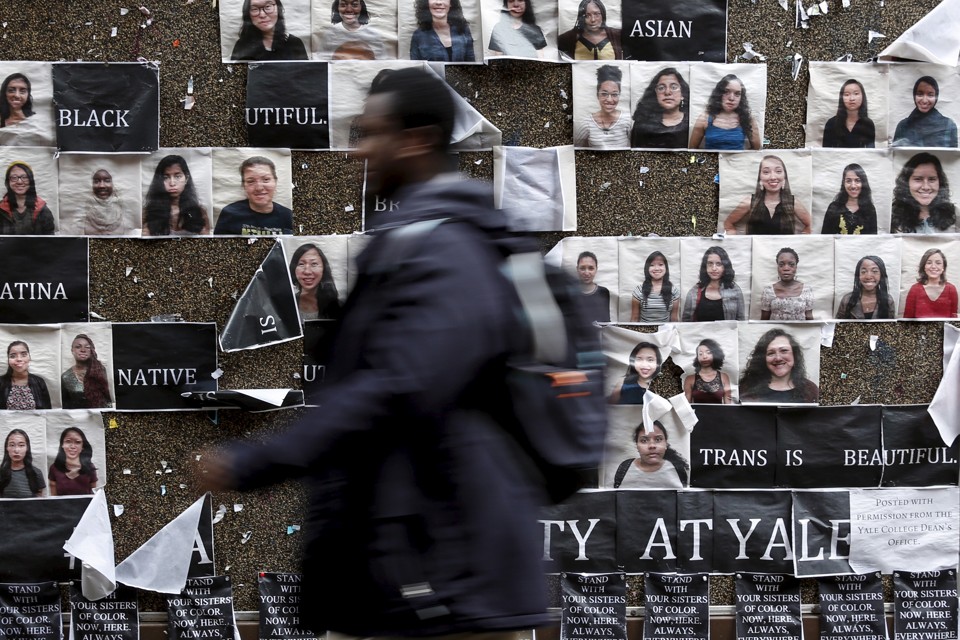The number of Ph.D. graduates from underrepresented groups grew by nine times since 1980. The number of assistant professors from those groups grew by just 2.6 times.
By Ed Yong
The Atlantic, NOV 22, 2016 —

A Yale student walks past a college noticeboard, prior to a college-wide discussion on race and diversity. (Shannon Stapleton / Reuters)
In late 2015, college students throughout America carried out a long series of protests against the “systemic and structural racism” that they saw on their campuses. They made several demands, the most common of which was to increase the diversity of their college professors.
Kenneth Gibbs, Jr., an immunologist and science-policy expert at the National Institute of General Medical Sciences, could relate. He saw the same lack of high-level diversity in his own career. And he saw it in reports showing that underrepresented minorities get just 6 percent of grants from the National Institutes of Health, even though they make up 32 percent of the U.S. population.
But when talking about the problem, Gibbs kept hearing the same refrain. Maybe there just weren’t enough good, qualified minority candidates to fill those posts. Maybe the lack of color at the top reflected a lack of talent at the bottom. “Some people just say, ‘Hey there are no minorities out there,’” he says. “And I think, ‘There are 100 in my Facebook.’”

Kenneth Gibbs Jr., Ph.D.
So, Gibbs gathered figures on the numbers of Ph.D. graduates and assistant professors in the science departments of medical schools throughout the country, from 1980 to 2014. The data were stark. During that time, the number of newly minted Ph.D. holders from underrepresented groups grew by nine times, but the number of assistant professors from those groups grew by just 2.6 times. No such gulf existed for well-represented groups like whites and Asians; there, the Ph.D. graduate pool grew by 2.2 times while the assistant professor pool rose proportionally, by 1.7 times.
If anything, the situation for underrepresented minorities is getting worse.
Gibbs found that between 2005 and 2013, almost 6,000 scientists from those groups earned their doctoral degrees, while the number of assistant professors fell by six. “If you assume the system will take care of itself naturally as you diversify the talent pool, this calls that in to question,” he says.
“Saying that there are not enough applicants in the pool can no longer be an excuse,” says Mónica Feliú-Mójer, vice-director of Ciencia Puerto Rico, a non-profit that supports and mentors Latino scientists. “It hasn’t been for underrepresented minorities like me for a long time, but now there’s data to refute it. It provides validation to the many anecdotes from those of us working to enhance diversity in the biomedical workforce. I hope that this makes our work a little easier.”
But why does the gap exist? Donna Ginther from the University of Kansas wonders if it’s partly because Gibbs focused on medical schools, most of which do not guarantee salary with tenure, and so might be unattractive when compared to other alternatives. Perhaps scientists from minority groups are just seeking employment elsewhere. Gibbs counters that this is unlikely, since almost every sector of academia struggles with faculty diversity.
www.nsf.gov/statistics/2015/nsf15311/tables/pdf/tab9-21.pdf
Hiring practices are a likelier culprit. As Marybeth Gasman, from the University of Pennsylvania, recently wrote in the Washington Post, “faculty will bend rules, knock down walls, and build bridges to hire those they really want (often white colleagues) but when it comes to hiring faculty of color, they have to ‘play by the rules.’” They start talking about “quality,” Gasman says, which typically means that “the person didn’t go to an elite institution for their Ph.D. or wasn’t mentored by a prominent person in the field”—opportunities that are often denied to people of color.
People of color are also more likely to drop out of the academic world. In an earlier study, Gibbs showed that women and underrepresented minorities are 36 to 54 percent less likely than white and Asian men to be interested in faculty careers, even after accounting for their publication record, their belief in their own abilities, and how interested they were when they entered their Ph.D. programs. That’s tragic. Regardless of their talent, confidence, and dreams, they were less likely to want to stay in research.
“That suggests the environment isn’t one where all scientists feel they can contribute and thrive,” says Gibbs.
The neuroscientists Daniel Colon Ramos and Alfredo Quinones-Hinojosa hinted as much in a recent New York Times op-ed. “Our minority trainees are exhausted,” they said. “They are drained by the constant bombardment of narratives and stereotypes that compromise their ability to focus on their training. The prejudice is crushing their creativity and stifling their innovation. It is suffocating a generation of biomedical researchers.”
These effects are such that, even without any overt racism on the part of hiring committees, the lack of diversity among professors won’t change without active effort. Gibbs showed this by creating a mathmatical model that simulated the flow of Ph.D. graduates into assistant professor positions. In the simulation, candidates compete for available positions for a few years before dropping out. Those from different ethnic groups apply at the same rates that Gibbs found in his earlier work. And they’re hired in direct proportion to their representation in the market, assuming no racial bias among their recruiters.
Even without such biases, the simulations showed that by 2030, underrepresented minorities will account for just 6 percent of assistant professors, even if they continue to get doctoral degrees at an exponentially rising rate, and even if there are 100 more professorships a year. Put another way:
You can grow the talent pool all you like, but unless you create an environment where underrepresented minorities want to stay in academia, that pool will continue to drain away.
Creating such an environment isn’t rocket science, says Gibbs. “If you talk to people about what they need to feel supported, and then do that, you can make change.”
“In the 1970s and 1980s, when the applicant pool of minority talent was much smaller than today’s levels, anecdotal experience and social justice imperatives were enough to motivate institutions to improve faculty diversity,” says , Alberto Roca executive director of DiverseScholar. “No peer-reviewed “diversity” studies were necessary to justify proactive recruiting. Instead, institutions simply hired minorities.”
“What’s missing today is strong support from an organization’s senior leadership to ensure that a faculty job opening has a diverse candidate pool,” Roca adds. “If a search committee or hiring department has not made a proactive effort to attract underrepresented minority candidates, then the organization needs to try harder or face the consequence that the search is halted. Campus leadership need to exercise such power to signal diversity as a priority.”
Changes don’t have to be big ones. Gibbs’ simulations showed that if two-thirds of medical schools hired and kept just one faculty member from an underrepresented minority every year for the next six years, the system would reflect the Ph.D. pool within a single tenure cycle. “It’s not a quota,” he says. “It’s a mathematical reality.”
“While I’d love for us to eradicate all racial biases in all sectors of society, we don’t need to do that to make substantial progress with the talent pool we already have,” he adds. “I have a 1-year-old and a 2-week-old. If they get into this path, I’d love for them to not have the same conversation I’m having right now.”











